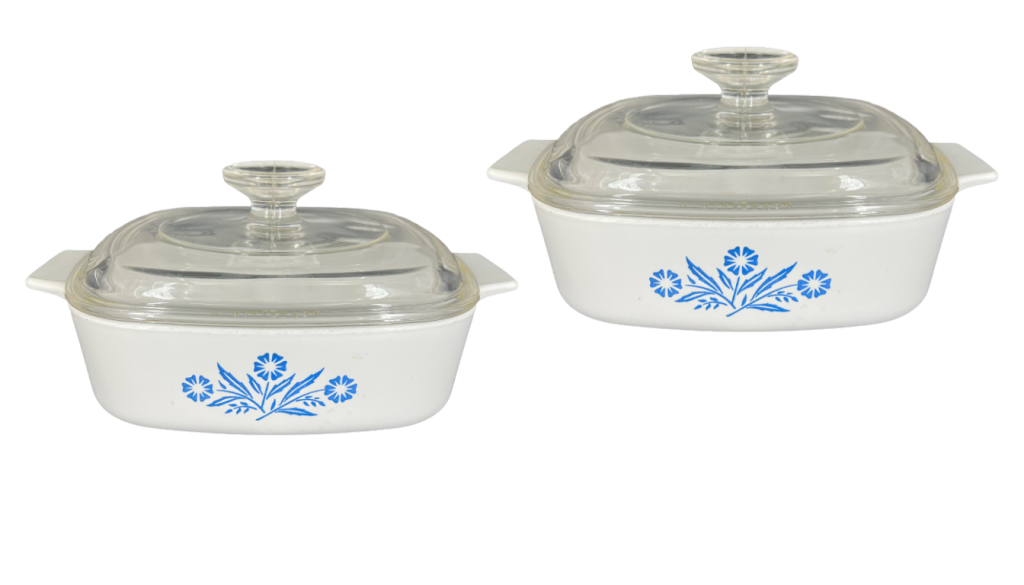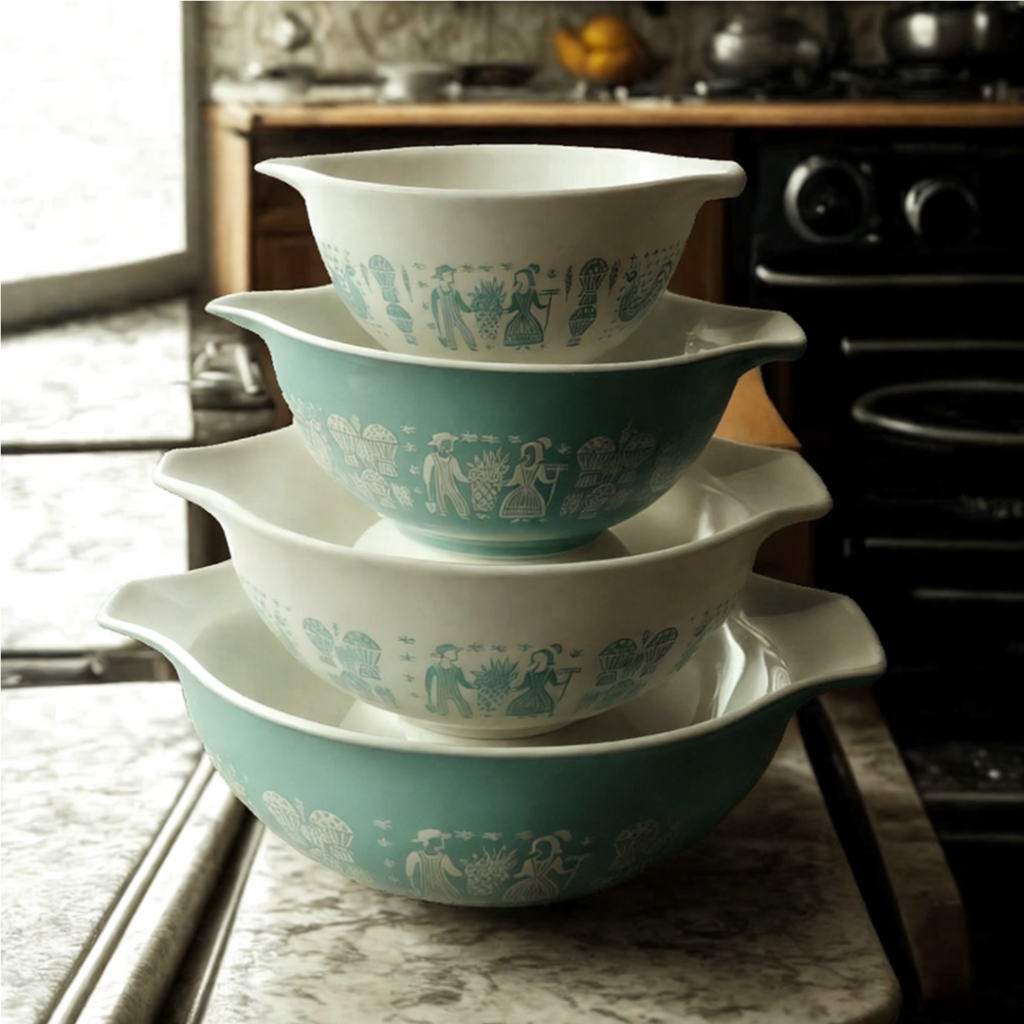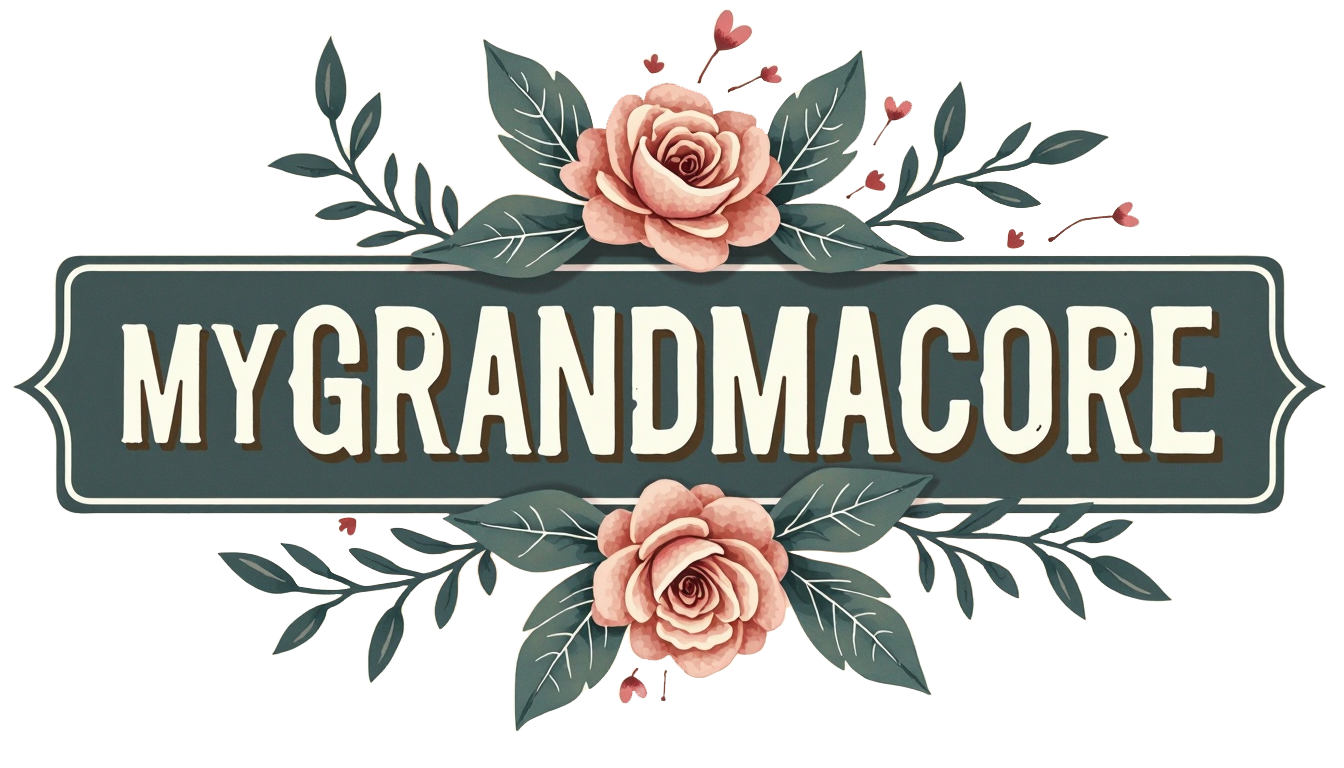Key Takeaways
Here’s what you need to remember from our vintage cookware deep dive:
✨ Both brands are GrandmaCore gold – Corningware and Pyrex each bring authentic vintage charm to your kitchen
🏆 Corningware wins for durability – That Pyroceram material is practically indestructible and handles extreme temperatures like a champ
🌈 Pyrex wins for visual impact – Those bright colors and see-through cooking create stunning displays and functional beauty
💰 Pyrex has higher investment potential – The collector market is hot right now, but it’s also more volatile
👩🍳 Corningware is better for daily cooking – Stovetop safe, oven safe, freezer safe – it does it all
🎨 Mix and match for the best look – Blue Cornflower casseroles with Butterprint mixing bowls? Chef’s kiss!
🔍 Authentication matters – Look for flame logos on Corningware and proper stamps on Pyrex bottoms
🛒 Start small and build slowly – One beautiful piece at a time beats buying everything at once
You know that feeling when you walk into your grandmother’s kitchen? The smell of something delicious in the oven, those beautiful blue and white dishes displayed on open shelves, and that unmistakable sense of home that just wraps around you like a warm hug?
Well, guess what? That cozy GrandmaCore aesthetic is having a major moment right now, and I’m absolutely here for it! But here’s the thing – if you want to nail that authentic vintage vibe, you need the right cookware. And that brings us to the age-old question: Corningware or Pyrex?
I’ve been deep-diving into both brands (okay, maybe I’m slightly obsessed), and I’m ready to spill all the tea about which one deserves prime real estate in your GrandmaCore kitchen.
First Things First – What’s This Grandmacore Thing About?
If you haven’t heard of GrandmaCore yet, let me paint you a picture. It’s that delightfully nostalgic trend that celebrates everything we loved about our grandmothers’ homes – the handmade doilies, the floral patterns, the way everything felt so warm and lived-in.
Think about it: soft pastels mixed with cheerful pops of color, vintage dishware that tells stories, and that perfect “come sit and have some tea” vibe. It’s comfort food for your soul, but in home decor form.
And here’s why vintage cookware is absolutely essential to pulling off this look:
- It’s functional AND gorgeous (hello, form meets function!)
- Each piece has history – you can practically feel the love that went into family meals
- The patterns are pure eye candy when displayed on open shelving
- It creates that authentic, not-trying-too-hard vibe we’re all after
Now, let’s get into the good stuff – comparing these two vintage legends.
Meet Corningware: The Original Oven-to-Table Superstar

Picture this: it’s 1958, and some brilliant minds at Corning decide to change the game forever. They create the first cookware that can go straight from oven to dinner table without missing a beat. Revolutionary? Absolutely.
The Patterns That Stole Our Hearts
Blue Cornflower – The OG Pattern Oh my goodness, can we talk about Blue Cornflower for a hot minute? This pattern launched in 1958 and became THE face of Corningware. Three simple blue cornflowers on crisp white – it’s like the little black dress of vintage cookware. Timeless, elegant, and goes with everything.
Fun fact: the early pieces had these adorable sloped sides and tiny handles. If you find one of those babies, hold onto it tight – they’re worth serious money now!
Spice O’ Life – The Groovy Seventies Star This one screams “I was born in the ’70s and I’m proud of it!” Picture earth tones, vegetables, mushrooms, and that whole harvest vibe. The early versions even had French inscriptions (fancy!), and collectors are paying over $1,000 for complete sets. No joke.
Why Corningware is So Darn Tough
Here’s what blows my mind about vintage Corningware – it’s made from something called Pyroceram, which was originally developed during World War II. This stuff can handle anything you throw at it:
- Freezer to 500°F oven? No problem
- Thermal shock? It laughs in the face of temperature changes
- Daily use for 60+ years? Still going strong
I mean, when was the last time you bought something that your great-grandchildren might still be using?
What’s It Worth These Days?
Okay, let’s talk numbers because I know you’re curious:
- Your everyday Blue Cornflower piece: $15-75 (totally reasonable!)
- Rare patterns with original lids: $100-500 (getting fancy)
- Those early sloped-side pieces: $1,000-1,500 (investment territory)
- French Spice with inscriptions: $1,200+ (holy moly!)
Now Let’s Chat About Pyrex: The Colorful Kitchen Queen

Pyrex has been around since 1908, but it really hit its stride in the 1940s and ’50s when they started making those gorgeous colored pieces we all obsess over today.
The Patterns We Can’t Stop Collecting
Amish Butterprint – The Farmhouse Darling If GrandmaCore had a mascot, it would probably be Butterprint. This pattern features the sweetest Amish couple with roosters and corn – pure farmhouse poetry! Made from 1957 to 1968, it came in that dreamy turquoise and white combo that makes my heart sing.
Those Iconic Mixing Bowls Can we just take a moment to appreciate the genius of Pyrex nesting bowls? Yellow, green, blue, red – they’re like little bowls of sunshine that happen to be incredibly functional. Plus, they look absolutely stunning when displayed together.
Gooseberry – The Cinderella Story Named after the Cinderella-style bowls (you know, with the cute handles), Gooseberry came in so many color combos. Pink on white, black on yellow – each one more charming than the last.
Why Vintage Pyrex Hits Different
Here’s the thing about vintage Pyrex – it was made with borosilicate glass, which is basically the Rolls Royce of glass. Modern Pyrex? Not so much. They switched to regular soda-lime glass in the ’90s, and trust me, it’s not the same. (Learn more about vintage Pyrex here.)
Vintage Pyrex perks:
- See-through cooking (watch your casserole bubble away!)
- Superior heat resistance (the real borosilicate magic)
- Even heat distribution (no hot spots here)
- That satisfying weight in your hands
The Pyrex Price Explosion
Friends, the Pyrex market has gone absolutely bananas lately. We’re talking:
- Basic mixing bowl sets: $50-150 (entry level)
- Rare patterns: $500-2,000 (getting serious)
- Complete Butterprint collections: $1,000-5,000 (collector heaven)
- Ultra-rare finds: Up to $10,000 (yes, really!)
The Ultimate Face-Off: Corningware vs Pyrex
Round 1: Durability (Winner: Corningware)
Look, I love Pyrex, but Corningware is basically indestructible. That Pyroceram material doesn’t mess around. You can literally take it from the freezer and pop it in a hot oven – something that would make Pyrex very unhappy.
Round 2: Cooking Versatility (Winner: Corningware)
Corningware takes this one because the vintage pieces are stovetop safe too. Pyrex is amazing, but it’s more of a “baking and serving” situation.
Round 3: Visual Appeal (Winner: It’s a Tie!)
This is where it gets interesting. Corningware gives you that elegant, understated vibe with its floral patterns. Pyrex brings the party with those bold, cheerful colors. Both are absolutely perfect for GrandmaCore – it just depends on your personal style.
Round 4: Investment Potential (Winner: Pyrex)
The Pyrex market is on fire right now. While it’s more volatile, the potential returns are pretty impressive. Corningware is steadier but slower to appreciate.
So Which One Should You Choose?
Here’s my honest take on this:
Go Team Corningware If:
- You actually want to cook with your vintage pieces daily
- You love subtle, timeless patterns
- You want something that’ll last through the apocalypse
- You’re drawn to that classic blue and white aesthetic
Go Team Pyrex If:
- You want to create those Instagram-worthy rainbow displays
- You love seeing your food cook through the glass
- You’re treating this as an investment opportunity
- You’re all about those bright, happy colors
My Real-World Advice
Want to know what I really think? Why choose just one?
Start with whichever brand speaks to your heart, then slowly add pieces from the other. I’ve seen the most beautiful GrandmaCore kitchens that mix Blue Cornflower casseroles with turquoise Butterprint mixing bowls. It’s like they were meant to be together!
Smart Shopping Tips (Because I’ve Made ALL the Mistakes)
Authentication 101:
- Corningware: Look for that flame logo and “Made in USA”
- Pyrex: Check the stamps on the bottom and feel the weight
Where to Hunt:
- Estate sales (my personal favorite treasure hunts!)
- Thrift stores (patience required but oh-so-rewarding)
- Etsy and eBay (convenient but watch those prices)
- Antique malls (great for browsing and learning)
Red Flags to Avoid:
- Chips or cracks (beauty is only skin deep)
- Missing lids (they’re harder to replace than you’d think)
- Prices that seem too good to be true (probably are)
The Bottom Line, Friend
Both Corningware and Pyrex deserve spots in your GrandmaCore kitchen. They each bring something special to the table – literally and figuratively. Corningware gives you that reliable, elegant foundation, while Pyrex adds personality and color.
The most important thing? Choose pieces you’ll actually use and love. Your grandmother didn’t keep her beautiful dishes locked away in a cabinet – she used them to create memories around the dinner table.
So whether you fall for the quiet charm of Blue Cornflower or the cheerful abundance of Butterprint, you’re not just buying cookware. You’re investing in pieces that will help you create that warm, welcoming atmosphere that makes everyone want to linger a little longer in your kitchen.
And honestly? That’s what GrandmaCore is really all about – creating spaces that feel like home, one beautiful vintage piece at a time.
Frequently Asked Questions
Q: Is it safe to use vintage Corningware and Pyrex for cooking?
A: Absolutely! Vintage Corningware is incredibly safe and durable – that’s why it’s lasted 60+ years. Just avoid extreme temperature changes with any pieces that have chips or cracks. Vintage Pyrex made with borosilicate glass is actually safer than modern versions, but handle with care when it comes to temperature changes.
Q: How can I tell if my Corningware is vintage?
A: Look for the flame logo and “Made in USA” markings on the bottom. Vintage pieces were made before 2000 when production moved. Early Blue Cornflower pieces have sloped sides and smaller handles – those are the real treasures!
Q: Why is vintage Pyrex so expensive now?
A: A few things happened – the original manufacturer went bankrupt, creating scarcity buzz, plus millennials started collecting pieces from childhood memories. Rare patterns like complete Butterprint sets can fetch thousands because they’re genuinely hard to find in perfect condition.
Q: What’s the difference between borosilicate and regular glass?
A: Borosilicate glass (used in vintage Pyrex) expands about 33% less when heated compared to regular glass. This makes it much more resistant to thermal shock – meaning it won’t crack as easily when going from cold to hot. Modern Pyrex uses soda-lime glass, which isn’t as heat-resistant.
Q: Can I put vintage cookware in the dishwasher?
A: While both are technically dishwasher safe, I’d recommend hand washing your vintage pieces to preserve the patterns and prevent chips. These beauties have survived decades – treat them with the love they deserve!
Q: What should I look for when buying vintage pieces?
A: Check for chips, cracks, or fading patterns. Make sure lids fit properly (original lids are worth more). Look for authentic markings on the bottom. If buying online, ask for detailed photos of any wear or damage.
Q: Are reproductions worth buying?
A: Modern reproductions can be great for daily use, but they won’t have the same collectible value or often the same quality as vintage pieces. If you want the authentic GrandmaCore vibe, stick with the real deal from estate sales and thrift stores.
Q: How do I display vintage cookware in my kitchen?
A: Open shelving is your best friend! Group pieces by color or pattern, mix in some vintage linens or pottery for texture, and don’t be afraid to use your beautiful pieces daily. The lived-in look is what GrandmaCore is all about.
Q: What’s the best way to store vintage cookware?
A: Stack carefully with tissue paper or soft cloth between pieces. Store lids separately to prevent chips. Keep pieces in a dry place away from extreme temperature changes. If you have rare pieces, consider displaying them rather than stacking.
Q: Should I buy complete sets or individual pieces?
A: Start with individual pieces you’ll actually use, then build your collection over time. Complete vintage sets are expensive and often more than most people need. Plus, mixing and matching different patterns creates that authentic, collected-over-time GrandmaCore look!
Happy collecting! 🌸
